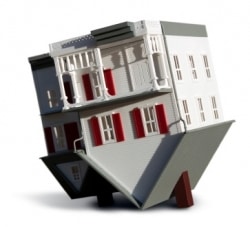We are stuffed full of home makeover shows. By my quick count there are about 75 different shows on one cable channel, HGTV, that are largely devoted to disguising houses, and a dozen more on other channels. There are design-in-a-whirlwind shows, gut-the-house shows, paint-each-wall-a-different-color shows, bloat-this-house shows (in which 3000 square feet metastasize to 7000 square feet), shows to envy dream houses and shows to pity “desperate houses.”
Most of the shows, no matter the premise, are the same: hope lies in quick fixes, in bold paint schemes, mirrors, cutesy photo displays, contrived twists of fabric. You know the drill: the opening shots of a distressed house are followed by the intervention of designers and shopping trips, the frenzied demolition and painting and loading in of the required stainless steel appliances. And then the final “reveal:” Oh! and Oh! again say the home owners. We never thought our house could be like this! We have a motif now! We never had a motif! Happy endings. Another family has entered real estate Valhalla. Salvation through consumption. (No surprise. Some of the commercials blend in seamlessly.)
But too often the glittering results do nothing to address the real weaknesses of the house. The interior space is usually bad – dim rooms as narrow as a single bowling alley, rooms in which every door, window, cabinet and light switch is in the wrong place. These design shows are just renovating deck chairs on the Titanic. They only deal with surfaces. Taking their cue from the fashion industry, they try to drop and raise the hemline on your kitchen. (“Dated” appliances and bathrooms are big sins.) These shows are working in a long tradition of faux finishes and false fronts. As the 19th Century architect, Leopold Eidlitz, said, “American architecture is the art of covering one thing with another thing to imitate a third thing which, if genuine, would not be desirable.”
The real “design challenge” isn’t the window treatment or the clutter by the door. These shows are tarting up houses to compensate for how unsheltered people feel. The real problem is that too many of our houses are no longer dwellings. They don’t feel like home. Dwelling is an old fashioned word that we’ve misplaced.
When we live heart and soul, we dwell. When we belong to a place, we dwell. Possession, they say, is nine-tenths of the law, but it is also what too many houses and towns lack. We are not possessed by our home places. Dwelling has left our buildings. We have “housing” without dwellings. We have Home Depot, but not home. This lost quality of dwelling – the soul of buildings – haunts most of our houses and our landscape.
The houses that seem the most home-like are the ones that are settled each day—in which each activity binds the people to the place, planting or building or being in a way so that house, land, and people seem to be breathing at the same rate. But if we’re not here, then our homes are not here. These days it seems we are running short of here. We have a heap of now—but it’s a placeless now.
Samuel Mockbee had a good, concise definition of dwelling. Mockebee was the wizard/architect who started Alabama’s Rural Studio, in which architecture students design and build homes for the poorest of the poor. He said, “Everyone, rich or poor, deserves a shelter for the soul.” Our houses shelter us from the rain and snow and sun, but our houses aren’t sheltering our souls. They aren’t nourishing.
These shows give us what we ask real estate agents and builders for. We ask for “great rooms” and “upgrades”: granite counters, luxurious “spa bathrooms,” home theaters, walk-in closets the size of Wyoming. But we should ask: Give us room for tumult and quiet, for solitude and passing the time with friends. Give us room for ordinary pleasures, for a day well lived. We should be hunting for the ordinary.
We have many cable channels shoveling shows at us that are essentially junk food. Empty calories. None of these shows are about finding the lasting qualities of good houses. You can see this on the house hunting shows. People walk through looking at awkward rooms, tiny rooms, and big showy rooms that they will spend a fortune to furnish and never use. No one ever asks: Which direction is this house facing? Will we have good morning light for breakfast? No one asks: How many extra years will I have to work to pay for this showy “cathedral ceiling?” How much of my life am I trading for space we’ll never use? No one questions the basic container they are being led to inhabit.
Lacking the right questions, we’ll go on covering one thing with another thing to create a false oasis. It’s good for business, but it’s a bad way to make people feel at home.
